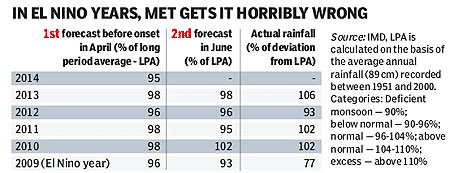The Met department?s first forecast says the monsoon rains will likely be 95% of long period average (LPA), or just below the ?normal? range of 96-104% of LPA, reports fe Bureau in New Delhi. What is worrying is that even the first forecast gives a 23% probability of a ?deficit? monsoon, which implies rainfall below 90% of the LPA, calculated on the basis of the average annual rainfall (89 cm) recorded between 1951 and 2000. The first monsoon forecast for the year 2014 released on Thursday by India Meteorological Department (IMD) gives another 33% probability to ?below normal? monsoon and 35% chances for ?normal? monsoon.
The met department’s next forecast, the more definitive one since it comes after the onset of monsoon, will be announced in June.





As the graphic shows, in a year when the El Nino weather pattern affects the rainfall, there has been a big difference between each forecast. Between 2010 and 2013, there was no great deviation between the first forecast and the actual rainfall received during the monsoon months (June-September).
But in 2009, the last year affected by drought, the met department’s first forecast was 96% of LPA. The second forecast in June predicted rains at 93% of LPA, while the actual rainfall was only 77% of LPA. In 2009, when the rainfall was 23% below normal, the foodgrain production dropped to 218 million tonnes (mt) from 234 mt in the previous year, a decline of 6.8%.
“It’s an indicative forecast which would help the state governments prepare themselves for kharif production in advance,” D S Pai, head of the forecast division of IMD, told FE from Pune.
Monsoon rains usually enters the country through the Kerala coast in the first of June and cover the entire country during the next four to six weeks.
On the impact of El Nino on the monsoon, IMD said in a statement, ?latest forecast from a majority of the models also indicate warming trend in the sea surface temperature over the equatorial Pacific reaching to El Nino level during the south-west monsoon season with a probability of around 60%.”
“The emerging El Nino does point towards likely below normal rainfall, though much would depend on what happens to it in the coming two months,? Ashok Gulati, chair professor?agriculture, Indian Council for Research on International Economic Relations, told FE.
Recently the private weather analysis agency Skymet had predicted a below-normal monsoon. It had predicted the monsoon rains during June-September to be 94% of LPA.
Monsoon rains are crucial for agriculture as about 40% of the cultivable area is under irrigation and around 55% of the foodgrains production, mainly paddy and coarse grains, is contributed by kharif or summer crop. The monsoon rains during the June-September period also helps boosting the soil moisture for the rabi or winter crop.




















